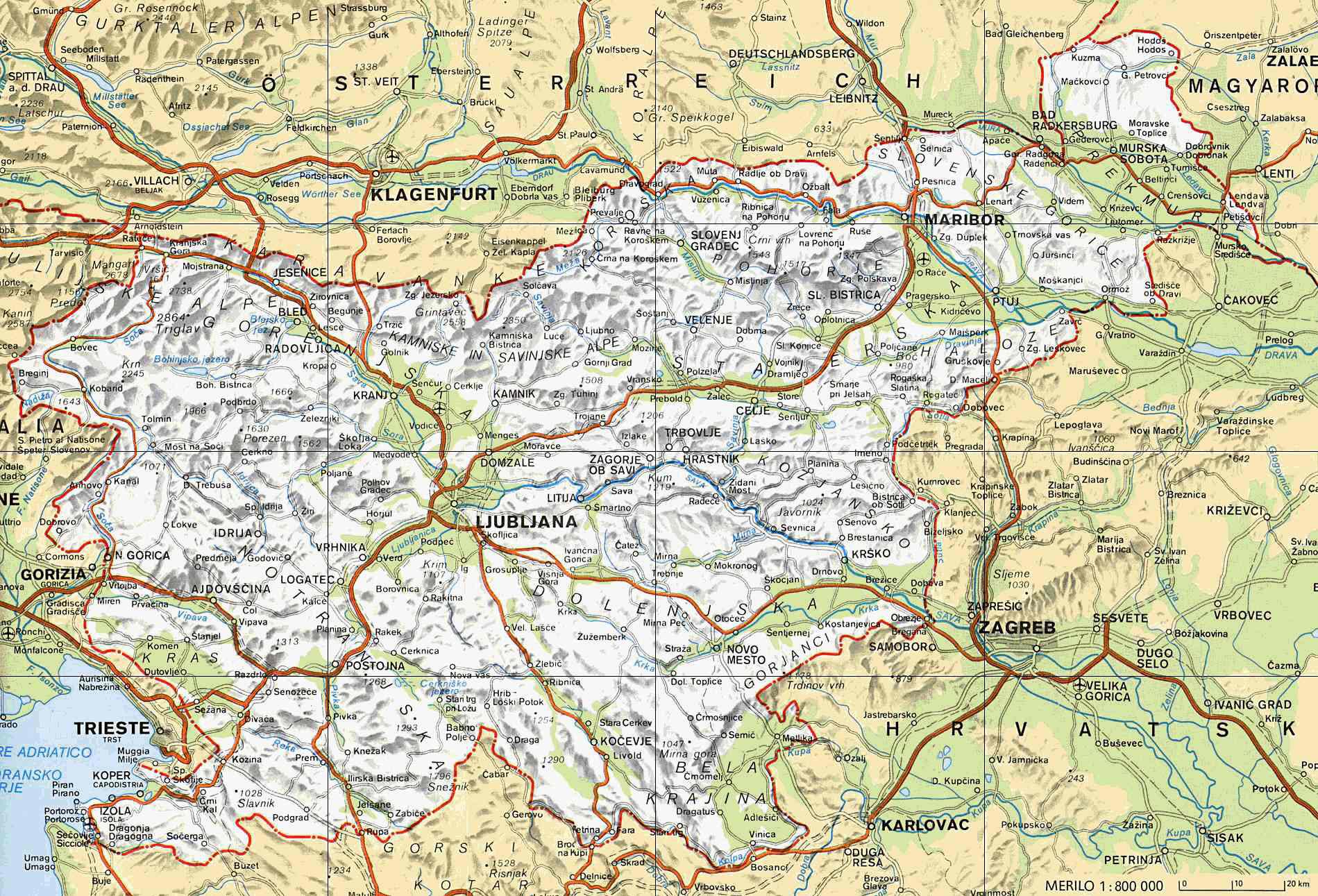
| ◄ | REPUBLIC of SLOVENIA |
| __________________________________________________________________________________________________________________________________________________________________________ |
| Sloveni, officially the Republic of Slovenia, is a country located in Central Europe at the crossroads of main European cultural and trade routes. It is bordered by Italy to the west, Austria to the north, Hungary to the northeast, Croatia to the southeast, and the Adriatic Sea to the southwest. Slovenia covers 20,271 square kilometers and has a population of 2.111 million. One of the successor states of the former Yugoslavia, Slovenia is now a parliamentary republic and member nation of the European Union, United Nations, and NATO. The capital and largest city is Ljubljana. Slovenia has a mostly mountainous terrain with a mainly continental climate, with the exception of the Slovene Littoral, which has a sub-Mediterranean climate, and of the Julian Alps in the northwest, which have an Alpine climate. Additionally, the Dinaric Alps and the Pannonian Plain meet on the territory of Slovenia. The country, marked by significant biological diversity, is one of the most water-rich in Europe, with a dense river network, a rich aquifer system, and significant karst underground watercourses. Over half of the territory is covered by forest. |
| The human settlement of Slovenia is dispersed and uneven. Slovenia has historically been the crossroads of Slavic, Germanic, and Romance languages and cultures. Ethnic Slovenes make up more than 80% of the population. Serbs are the largest minority. The South Slavic language Slovene is the official language throughout the country. Slovenia is a largely secularized country, but Catholicism and Lutheranism have significantly influenced its culture and identity. The economy of Slovenia is small, open and export-oriented and is thus strongly influenced by the conditions of its exporting partners' economies. This is especially true with Germany, Slovenia's biggest trade partner. Like most of the developed world, Slovenia was severely hurt by the Eurozone crisis beginning in 2009, but started to recover in 2014. The main economic driver for the country is the services industry, followed by manufacturing and construction. |  |
Historically, the territory of Slovenia has formed part of many different states, such as: the Roman Empire, Byzantine Empire, Carolingian Empire, the Holy Roman Empire, the Kingdom of Hungary, the Republic of Venice, the Illyrian Provinces of the First French Empire, the Austrian Empire and Austro-Hungarian Empire. In October 1918, the Slovenes exercised self-determination for the first time by co-founding the State of Slovenes, Croats and Serbs. In December 1918 they merged with the Kingdom of Serbia into the Kingdom of Serbs, Croats and Slovenes (renamed the Kingdom of Yugoslavia in 1929). |
The breakup of Yugoslavia occurred as a result of a series of political upheavals and conflicts during the early 1990s. After a period of political and economic crisis in the 1980s, constituent republics of the Socialist Federal Republic of Yugoslavia split apart.
Slovenia declared their independence on 25 June 1991. |
| Slovenian Presidency of the Council of the EU 2021 |
In the second half of 2021, Slovenia will hold the Presidency of the Council of the EU for the second time. We have already started the preparations for this very demanding project, as we have to ensure in a timely manner that all security, technical and logistics requirements for the organisation of meetings in Slovenia are fulfilled, along with designing activities for the promotion of Slovenia. Slovenia will again work together in the trio with Germany, which will hold the presidency in the second half of 2020, and Portugal, which will hold the presidency in the first half of 2021. |
In 2008, Slovenia held the Presidency for the first time, as the first of the twelve “new” member states that joined the EU in the 2004 and 2007 enlargements to do so. Slovenia’s Presidency follows its Trio partners Germany and Portugal.
|
REPUBLIC OF SLOVENIA GOV.SL |
Priorities during their Presidency were the Lisbon Treaty (timely entry into force), the new Lisbon Strategy Cycle (successful launching), Climate-Energy issues (a step forward in addressing), Western Balkans (strengthening of the European perspective), Intercultural Dialogue (promotion). |
 |
Slovenia: Trapped in the spirit of the past after 30 years of independence? (Deutsche Welle, June 24, 2021) In 1991, Slovenia broke away from what was then Yugoslavia. On June 25, the nation celebrates 30 years of independence. But how happy are Slovenians with the status quo?
"Dreams are allowed today, tomorrow is a new day" are words etched into the historical memory of Slovenians, also known as Slovenes. On June 25, 1991, they were uttered by Milan Kucan, then president of the Yugoslav Socialistic Republic of Slovenia and subsequently twice president of independent Slovenia. On that day, Slovenia declared its independence and officially separated from Yugoslavia. "You could sense his uncertainty from that last sentence," says Dusan Plut, then a member of Slovenia's presidency and president of the Greens of Slovenia. He had high expectations but as a politician he was also concerned about how independence would pan out. Following a referendum held on December 23, 1990, in which 95% voted in favor of Slovenian independence, the country's politicians unanimously decided to implement the outcome as soon as possible — "non-violently," as Plut emphasizes. Plut's disappointment with the stance of European policy and key European countries at the time, including Germany, is still tangible: "Back then, we did not get any support. In an attempt to prevent conflict, the emphasis at a European and international level was on preserving both border integrity and even the socialist sociopolitical system of Yugoslavia. Yet war occurred nevertheless." |